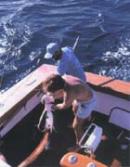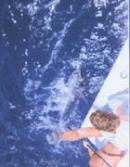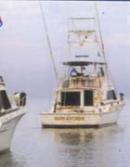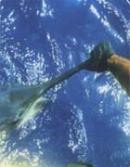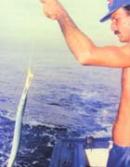Marlins off Havana’s shores
Every year, as soon as wintertime chilly winds and high tides start beating Cuba's northern shore for a few months, you might find every once in a while an angler near one of Havana's oceanfront streets wheeling off a handsome long-snout fish tied up to his rusty bike.
Marlin fishing as a sport activity is a sort of adventure many people dream of. Yet, only a handful of lucky guys pull it off as long as their spare time and deep pockets allow them to. It's just a shortlived spell that barely lasts the minutes or hours the fish remains in the water tethered to the fisherman by a taut line with a hook clawed inside the marlin's mouth on one end, and a rod and a reeling spool on the other.
The line's resistance is so huge that the marlin's weight can outdo it twice, fivefold or even more. Only the adequate caliper of his fishing gear and the angler's skills –combined with the boat skipper's experience and expertise- make the catch a dream come true before the line bursts in two or the enormous marlin pushes the tackles overboard.
When the fishing is carried out by holding several lines in trawl, the moment of dealing with one marlin is definitely the time of truth. That emotional pinnacle sometimes happens as soon as the vessel sails off the harbor –a few lucky anglers have had that experience in Cuba- but in most cases, several hours tick by and all the action fishermen see is the long wait on deck.
Hemingway crosses the Straits American writer Ernest Hemingway was barely making it big when he crossed the Florida Straits in 1932 aboard a friend's speedboat and came down to Havana for his first marlin fishing spree. A room in Ambos Mundos (Both Worlds) Hotel, just a few blocks away from the harbor, became a makeshift operation center for the novelist and his crew.
That same year he caught almost two dozen marlins and the waters washing Cuba's northwestern coastline captured his heart forever. The long-snout fish panned out to be Hemingway's obsession from the moment four years before in Dry Tortugas when he talked with Carlos Gutierrez, a Cuban-born fishing boat skipper.
The relationship of the marine undercurrent strength, the winds and an array of other weather conditions with marlins' willingness to take the bait, were documented by Hemingway in a chapter entitled “Marlin Off Cuba” that he eventually included in his 1935 book American Big Game Fishing.
How are marlins caught? Properly speaking, sport fishing is performed on outboard-motored boats nowadays equipped with long outriggers –large poles that help unreel the lines on both sides of the yacht. Rod and spool tackles –in a fishing system called trolling- are used to catch marlins with lines whose resistance ranges from 30 to 100-plus pounds. Sometimes catches are five to ten times heavier.
By and large, needlefish is the bait of choice in Cuba. The fish is cut in halves and some meat is sliced off from both sides. A chunk of it is then wrapped around the hook and the two free ends are tapered off to let the marlin flip as it pulls the troll. When a marlin bites this bait or an artificial lure resembling a gaudy squid –increasingly in use today- the line breaks free from the clip holding it tight on top of the outrigger and the spool begins to unreel in an unintelligible but unforgettable whizzing sound.
The basic rule to catch a big fish is to keep the rod firmly up as far as the creature swims away from the boat and then start reeling in by turning the spool handle as the rod sways rhythmically in a pumping motion. Your muscles will surely sweat it out this time. The denouement hinges on a variety of things –even good fortune- but eventually the toilsome effort grinds to a halt when the fish is next to the edge of the boat.
Marling fishing in Cuba There are a few good places in Cuba to go marlin fishing. Your chances, though, are much greater in the Gulf stream off the island nation's northwestern coasts stretching from Bahia Honda all the way to the east side of the coastal town of Santa Cruz del Norte. This makes up a 75-mile-long corridor where marlins show up not too far from the shoreline.
All along this coastline strip, there are a few spots where fishing aficionados know and practice marlin fishing. A case in point is Cojimar, the same town Hemingway put on the map. Today, Cojimar boasts the country's largest fleet of sport fishing boats.
If you travel to Havana as a tourist, there'll be chances galore for you to catch a marlin. No matter which side of the city your hotel is on. There's a couple of marinas –each with specialized fleets, guides, dry-behind-the-ear skippers, lodging offers and top-notch gourmet of its own, let alone several tournaments right in the nick of time before the fishing season begins.
One of those tourist ports in Havana is the Hemingway Marina. It used to be known as Leeward before being dubbed Marlin Village. Today, it's outfitted with four hurricane-proof canals and a grand total of 8,600 lineal meters of piers and wharves. Over a hundred docking spots equipped with drinkable water supply, power service, phone lines and security guards sprawl along the canals. Nonetheless, those facilities are only but a few examples of the marina's true potentials in this respect.
This marina is the proud host of Havana's International Nautical Club “Ernest Hemingway,” an entity that has introduced the tag-and-release system in Cuba in marlin fishing tournaments. The association's commodore, Jose Miguel Diaz Escrich, is also the representative of the International Game Fish Association (IGFA) in Cuba.
The aforesaid club –with a membership of little more than 1,000 from some 50 countries- organizes every spring the world-class Ernest Hemingway International Marlin Fishing Tournament. Another competition held in this marina is the Blue Marlin Tournament. When winter is closing in, the wahoo fishing tournament kicks off. The facility's star-studded competition comes in October –The Hispanic Tournament- while The Old Man & The Sea championship takes place every summer.
For tourists, fishing in Cuba is a cakewalk. If you came sailing aboard your own vessel, you can radio in your arrival by tuning the 16-band and 72-band VHF frequencies, or using the 7462 frequency from the single side band to exclusively get in touch with the Hemingway Marina. You can get a temporary deferrable visa upon arrival. Local agency ESICUBA extends insurance policies on deluxe boats. You can order this service by sending either a fax to (53-7)551457 or an e-mail to giraldo@chsic.get.cu.
Travelers can rent boats suitable for big-time fishing right at the Hemingway Marina. A four-hour trip for up to four anglers ranges from $300 to $400. At the Tarara Marina, this same service sets you back $230. In both cases, the service includes crews, tackles and baits. For further information, click on www.cubanacan.cu and www.puertosol.net.Have a nice fishing trip!

